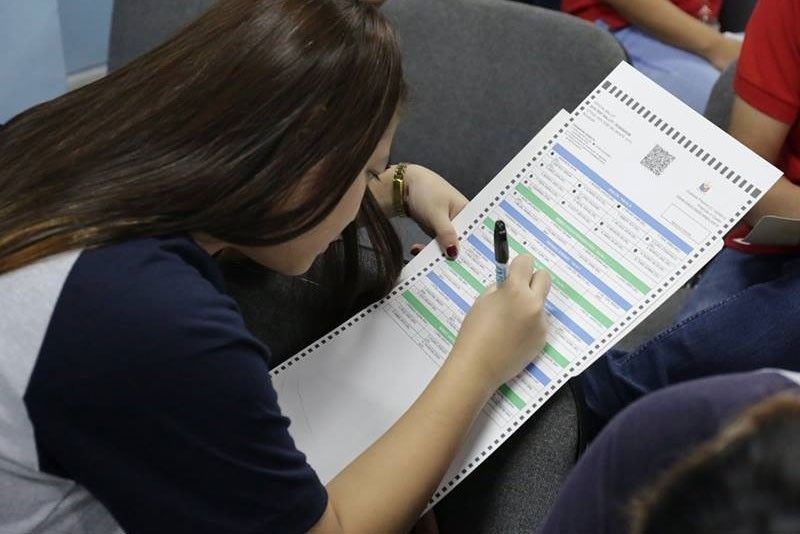Last-minute election woe: Pens blotting on ballots


Listing of 61,843,750 voters? Check. Printing of 63,662,481 ballots? Check. Deployment of 85,000 vote counting machines? Check. The Comelec claimed last Friday to be 95-percent ready for the congressional-local elections on May 13. Then alarming news broke. The special pens that voters are to mark their choices with are defective. Without those pens there can be no balloting, no counting, no election.
The pens had been procured months ago. Debut was last week’s advanced absentee voting. Only then was it discovered. The pens tended to smear, Ted Failon scooped on DZMM news radio. Ballots were at risk. Inkblots inadvertently could shade balloons beside candidates’ names. Optical scanners, the VCMs might count mere blots as votes or invalidate them. Comelec director for education and information Atty. Frances Aguindadao-Arabe confirmed another flaw. The blots can smudge the VCMs’ reading eye, also distorting the count. She said the defective pens were being recalled for replacement. Old pens from Elections 2010 and 2016 would be dug up for reuse.
Pressed by newsmen, Comelec spokesman James Jimenez called a briefing later Friday. The blotting pens were belittled as a mere “hiccup”. Supposedly it was nothing compared to the confusion of Election 2010. Jimenez recounted Comelec’s last-minute replacement then of 76,000 compact flash cards that VCM supplier Smartmatic wrongly had encoded.
Yet word trickled in from Comelec provincial offices of even worse problem. The ink supposedly bled to the back of the double-sided ballot. Meaning, the problem could be not just blotting pens but ballot porosity. Faulty pens can be replaced within days. But it would take weeks to reprint new ballots specialized for each locale’s list of contenders.
The issue still is hazy. Jimenez only said a million pens are being purchased, different from his colleague Aguindadao-Arabe’s prescribed remedy. Election watchdogs bristled at the scant information. Wary of past Comelec fiascos, a former director said the National Bureau of Investigation should be called in to ascertain if not only the pens but the ballots too are unworkable. Another insider warned that the agency’s “emergency procurements” usually contain up to 700-percent overprice.
The snafu makes counterchecks, like voting receipts, all the more crucial. Pending at the Supreme Court is a petition from poll watchdogs for full implementation of the voter verified paper audit trail (VVPAT). The 2007 Election Automation Law lists VVPAT among 15 basic features of a secure VCM. The Supreme Court compelled the Comelec to enforce the VVPAT starting Election 2016.
Comelec and Smartmatic illegally had discarded the VVPAT in Elections 2008, 2010, and 2013. Defying the SC in 2016, implementation was only partial. That year’s receipts were useless as paper audit trails for not containing the VCMs’ serial numbers, precincts, and locales.
This time around the watchdogs want full VVPAT processes. Plus, digital signatures (secret passcodes) of teachers serving as precinct election inspectors, another of the 15 security features. From the receipt on Election Day the voter is to check the accuracy of the VCM’s reading of his ballot choices, then drop it in the designated box. At the close of balloting, while the VCM officially tallies and transmits the results to the canvassing centers, volunteer voters can record the receipts by phone camera. That way, voters can audit the votes in their respective precincts. Mismatch means manipulation of results on the way to canvassing.
The pen and ballot problem also casts doubt anew on the pointless, costly automation of the balloting. Often has it been said that automation was to end large-scale “dagdag-bawas” (vote padding-shaving) during canvassing. There was hardly any cheating at the precinct level, except in the hinterlands of Lanao del Sur and Sulu. With at most 200 neighbors per precinct, voters knew and did not cheat each other. What needed automating was the transmission of results from the precincts, then the canvassing or consolidation at the municipal, city, provincial, congressional district, and national levels. That would cost only a few million pesos every election, using local hard and software. Not the tens of billions to lease-purchase, accessorize, and warehouse foreign VCMs.
* * *
Comelec overblows the role of Grab ride hailing to raise voter turnout on Election Day. In special deal with the agency, Grab drivers will give riders this week spiels on how to vote and fare discount on E-Day. Such encouragements supposedly would boost the anticipated 75-percent turnout to 81 percent.
The figures don’t add up, though. Grab’s 35,000 drivers are unable to service about 600,000 daily ride bookings in the metropolis, the firm said last year. Most riders are repeat bookers. With about 60 million voters, one percentage point equals 600,000, and the six-percentage-point boost, 75 to 81, would mean 3.6 million. Grab can’t pull in that many voters. Besides, only few voters will be commuting to distant voting precincts. E-Day being a holiday, voters mostly will come from home, and walk or tricycle to the polling center.
* * *
Catch Sapol radio show, Saturdays, 8-10 a.m., DWIZ (882-AM).
Gotcha archives on Facebook: https://www.facebook.com/pages/Jarius-Bondoc/1376602159218459, or The STAR website https://beta.philstar.com/columns/134276/gotcha
- Latest
- Trending






















